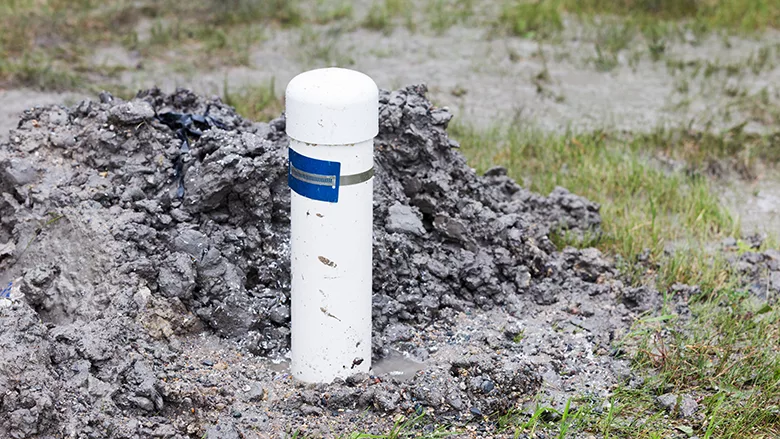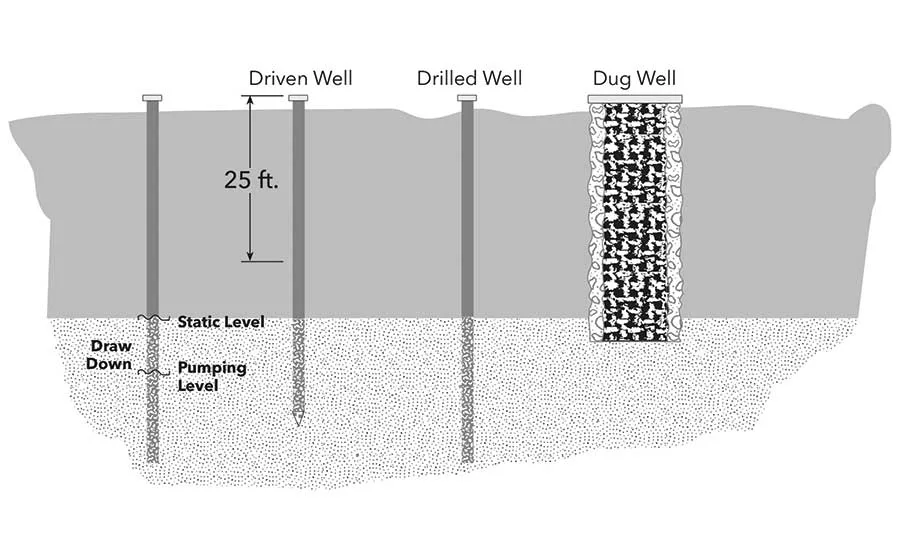What Are the Basic Components of a Residential Water Well?
Get to Know the Work that Groundwater Drillers Do


Drilled wells are most common, but household wells can also be driven or dug. Source: Xylem Inc.

A residential well system has several parts that work together to supply water to a household. Source: Xylem Inc.
In the following article, learn about the benefits of installing a residential water well as well as the basics of how a well is constructed and how to maintain it.
Water wells and well water systems play a crucial role in providing affordable, quality drinking water, especially to rural communities where traditional municipal water systems aren’t readily accessible.
With the recent passage of the Water Infrastructure Improvements for the Nation (WIIN) Act, small and rural communities now have greater flexibility to choose the clean water source that best suits their specific needs. The WIIN Act includes provisions of the Water Supply Cost Savings Act — a bipartisan legislation designed to promote awareness and assistance related to well water systems for rural communities. The legislation originally grew out of the Water Systems Council’s (WSC) efforts to provide wells as a cost-effective drinking-water solution to a limited number of families and communities in need. The WSC works to improve the water well industry through the discussion of market issues, industry education, regulations and more.
Water and groundwater investment has only accelerated with the passage of the Inflation Reduction Act and the Infrastructure Investment and Jobs Act. All of this federal legislation has created plenty of opportunities for homeowners to embrace groundwater.
For the latest water well news and how-to's, click here.
Water wells are a reliable, cost-effective way for budget-challenged communities to provide access to safe drinking water for their residents. According to the WSC, local projects completed through the Water Well Trust have realized savings as much as 94 percent over traditional long-pipe, centralized drinking water systems.
More than 23 million United Sates households use individual or private wells to supply water for their families. As awareness spreads about water well systems as a viable drinking water solution, it helps for homeowners and those fresh to the industry to know the basics of how water wells function. For customers, this is an important part of the decision-making process.
Benefits of Installing Residential Water Wells
Many communities are unaware of the benefits of installing water wells, which go beyond ensuring safe drinking water. For instance, well systems can provide clean water at a much lower cost than traditional municipal systems.
The WIIN Act provides assistance for small and disadvantaged communities with fewer than 10,000 residents to fully replace drinking water, wastewater and/or public water infrastructure that is in violation of the federal Clean Water Act. Communities can receive grants that cover the full replacement of lead-line systems, and communities seeking federal assistance for drinking-water infrastructure will be required to complete a self-certification process to ensure well systems have been assessed as a viable alternative.
Know the Basics
Proper well construction is key to the safety of a residential water supply. A well is a hole drilled into the ground to access water contained in an aquifer — natural areas of water storage under the ground. A pipe and pump are used to pull water from the aquifer, and a screen filters out unwanted debris that could clog the pipes in a residential water system or contaminate the water supply.
Before drilling, professional well drillers should call 811 (popularly known as "Miss Dig") to protect themselves and others from unintentionally piercing underground utility lines. When drillers call 811, they help prevent unintended damage to a property, an underground pump system or even an entire neighborhood that could cost thousands to repair.
The size of a well depends on the terrain and a customer's water needs. It is important that only professional water well contractors drill and install water wells. They are familiar with the hydrology of the area and can properly site, size and install a groundwater well.
While there are three basic types of wells — dug, driven and drilled — most modern wells are drilled or bored. This type of well requires the use of a drill rig. Often mounted on a big truck, drill rigs are fitted with powerful drill bits that can bore more than 1,000 feet deep. Drill rigs are used to access confined aquifers for water, rather than unconfined aquifers, which are prone to contamination. To prevent contamination from surface water, drilled wells are sealed. Drillers do this by filling the annulus — the gap between the well "casing" and the side walls of the hole — with grouting materials.
While a residential water well system is comprised of several components, the combination of the pressure tank, pressure switch and the pump allows water to flow through a home.
The pressure tank creates water pressure by using compressed air to bear down on the water and push it out of the tank and through the pipes in a home. It also acts as a reservoir, allowing water to be drawn from the tank without the pump cycling on and off every time the water is turned on.
A pressure switch senses a residential water well system’s pressure and automatically turns the pump on and off, regulating a home’s water supply. When the water pressure drops to a certain level, the switch senses that more water is needed and turns on the well pump. When the optimal water pressure is reached, the switch turns off.
A well pump propels water out of the ground. Submersible pumps, which push groundwater directly out of the well, are rapidly replacing jet pumps. Jet pumps — typically located in a pump house or basement — draw water from the well to the pump, and are less efficient and noisier than submersible pumps.
Reliable Water Pressure
One drawback of a traditional residential water well system is fluctuating or inconsistent water pressure. Thanks to a variable frequency drive, homeowners can expect a constant, continuous flow of water whether they’re doing laundry, giving the kids a bath or watering the garden — or all of those things at once.
A variable frequency drive controller — like Goulds Water Technology’s Aquavar SOLO 2 — monitors household water demands and provides constant water pressure. Like the cruise control on a car, the variable frequency drive speeds up or slows down the pump and motor depending on how much water is needed.
By providing pump and motor protection, variable frequency drive controllers reduce mechanical stress on well pumps, which minimizes the need for costly repairs. They also can reduce the energy consumption of a well pump and lower energy costs.
Proper Maintenance
Although it is often overlooked, well maintenance is very important to maintaining a safe and reliable water source.
Homeowners should keep a well log that contains the details of their water well system, including the depth of the well, the current water level and equipment information. These details will come in handy if a contractor needs to respond to a service call.
The quality of a water source may change over time, or even overnight. But changes can go unnoticed if there is no difference in the way the water looks, smells and tastes. For that reason, experts recommend testing residential well water at least once a year to determine if the treatment system is performing correctly, or if the quality of the source water has changed.
Looking for a reprint of this article?
From high-res PDFs to custom plaques, order your copy today!




